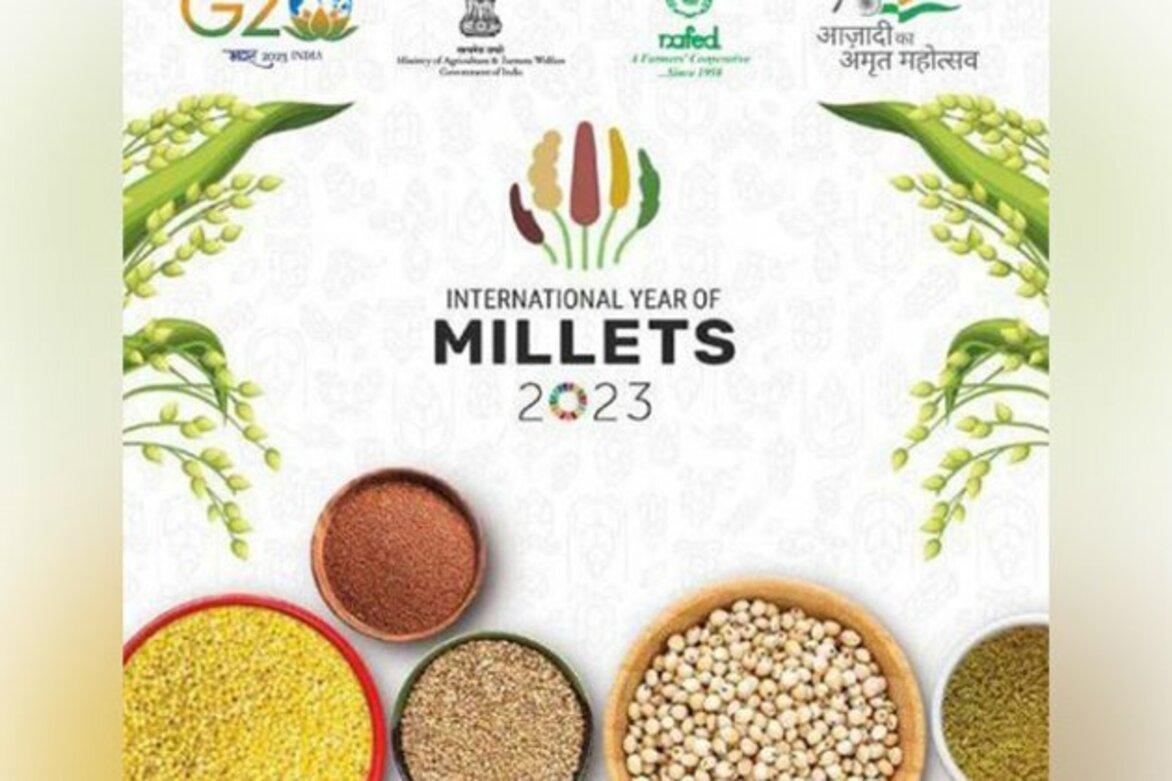Agriculture minister Tomar directs NAFED to promote millet year globally
ANI
20 Mar 2023

New Delhi [India], March 20 (ANI): Union agriculture minister Narendra Singh Tomar has directed its agency National Agricultural Cooperative Marketing Federation of India (NAFED) to promote the 'International Year of Millets 2023' on a global scale.
Accordingly, NAFED has started extending marketing linkage to millet-centric startups, setting up a millet corner in NAFED Bazaar Retail Stores, and installing of millet vending machines across Delhi NCR.
"We are also in process to establish a Millets Experience Centre at Delhi Haat, INA to promote nutritious Millets and create awareness on the rich history of India through Millet based dishes," said the ministry in a release on Monday.
NAFED has also developed premium quality millet gift hampers which have been showcased at the G20 1st Employment Working Group Meeting under the aegis of the Ministry of Labour and Employment at Jodhpur, Rajasthan. These hampers are developed with the idea to promote millers and demonstrate support and commitment to the promotion of such nutritious products.
Minister Tomar said all central ministries, and state governments including leading food and beverage industries, both public and private, should pitch in.
Tomar also pointed out that India assumed the G20 Presidency in December 2022 and is convening the G-20 Leaders' Summit for the first time in the country. He said, during the Presidency, which also coincides with the International Year of Millets, it provides an opportune time to showcase India's strength in the area of food security and nutrition in which millets will play a very important role.
India held its first mega-global event Global Millets (Shree Anna) Conference in Delhi last week to celebrate 2023 as the International Year of Millets (IYM). The aim of United Nations to declare 2023 as the International Year of Millets on India's initiative is to elevate awareness of millets for food security and nutrition, enhance investment in RD and extension, and to inspire stakeholders towards improving production, productivity and quality of millets.
A ministerial round table of millets was held post-inaugural session of the Global Millets (Shree Anna) Conference in New Delhi on Saturday.
Ministers from Guyana, Mauritius, Sri Lanka, Sudan, Suriname and Zambia; Permanent Secretary, Agriculture of Gambia and Maldives and Director General, Millets Initiative, Nigeria participated in the meeting.
The visiting ministers from major millets-producing countries shared the experience of their respective countries in promoting production, consumption and branding of millets. They all favoured closer linkage among major millets-producing countries.
All countries desired that India should provide good seed of improved varieties of millets, help in establishing small scale mechanization and capacity building, according to a government release. All ministers supported promotion of indigenous millet crops in their countries to free people from wheat consumption.
The government of India under Prime Minister Narendra Modi spearheaded the United Nations General Assembly (UNGA) resolution for declaring the year 2023 as the International Year of Millets and the proposal of India was supported by 72 countries.
What are millets?Millet is a common term for categorizing small-seeded grasses that are often called Nutri-cereals. Some of them are sorghum (jowar), pearl millet (bajra), finger millet (ragi), little millet (kutki), foxtail millet (kakun), proso millet (cheena), barnyard millet (sawa), and kodo millet (kodon).
An essential staple cereal crop for millions of smallholder dryland farmers across Sub-Saharan Africa and Asia, millets offer nutrition, resilience, income and livelihood for farmers, and have multiple uses such as food, feed, fodder, biofuels and brewing.
Significance and benefits of millets:Millets are nutritionally superior to wheat and rice owing to their higher protein levels and a more balanced amino acid profile. Millets also contain various phytochemicals which exert therapeutic properties owing to their anti-inflammatory and anti-oxidative properties.
Further, besides being climate resilient, millet grains are rich sources of nutrients like carbohydrates, protein, dietary fibre, and good-quality fat; minerals like calcium, potassium, magnesium, iron, manganese, zinc and B complex vitamins.
Most importantly, millet production is not dependent on chemical-based fertilizers.
Background of millets in India:Millets were traditionally consumed, but due to the push given to food security through Green Revolution in the 1960s, millets were less consumed and almost forgotten.Before the Green Revolution, millets made up around 40 per cent of all cultivated grains, which has dropped to around 20 per cent over the years.
India produces all the nine commonly known millets and is the largest producer and fifth-largest exporter of millets in the world.
Most of the states in India grow one or more millet crop species. Rajasthan, Uttar Pradesh, Haryana, Gujarat, Madhya Pradesh, Maharashtra, Karnataka, Tamil Nadu, Andhra Pradesh, and Telangana are the major millets producing states. (ANI)